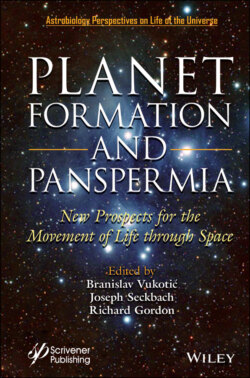Planet Formation and Panspermia

Реклама. ООО «ЛитРес», ИНН: 7719571260.
Оглавление
Группа авторов. Planet Formation and Panspermia
Table of Contents
Guide
List of Illustrations
List of Tables
Pages
Planet Formation and Panspermia. New Prospects for the Movement of Life through Space
Preface
References
1 “On the Origin of Life”
2. Why We Should Take Interstellar Panspermia Seriously
2.1 Introduction
2.2 The Case for Interstellar Panspermia
2.3 Theoretical Consequences of Interstellar Panspermia
2.4 Conclusions
References
3. The Extended Continuity Thesis, Chronocentrism, and Directed Panspermia
3.1 Introduction: The Continuity as a Pre-Requisite for Scientific Grounding of Astrobiology
3.2 Versions and Resistance
3.3 Cultural Evolution and Directed Panspermia
3.4 Conclusion and Prospects
Acknowledgements
References
4. Life in the Milky Way: The Panspermia Prospects
4.1 Introduction
4.2 Three Levels of Habitability and Panspermia
4.2.1 Stellar System Level
4.2.2 Galaxies: Cosmic Cradles of Life
4.2.3 Cosmological Level: Interactions of Galaxies
4.3 Conclusions
Acknowledgements
References
5. Planetary Protection: Too Late
5.1 Introduction
5.2 What is Planetary Protection
5.3 Extent of Earth Biosphere
5.4 Extension to Other Planetary Bodies
5.4.1 Moon
5.4.2 Mars
5.4.3 Icy Moons
5.5 Backward Contamination
5.6 Interplanetary Exchange
5.7 Habitable Conditions for Interplanetary Micronauts
5.8 Conclusion
Appendix A
Appendix B
Appendix C
Acknowledgments
References
6. Microbial Survival and Adaptation in Extreme Terrestrial Environments— The Case of the Dallol Geothermal Area in Ethiopia
6.1 Introduction
6.2 Planetary Field Analog: The Case of the Dallol Geothermal Area
6.2.1 The Dallol Hot Springs
6.2.2 Dallol Geothermal Area Planetary Field Analogs
6.3 Life in Extreme Environments
6.4 Conclusion and Remarks on Panspermia
Acknowledgements
References
7. Escape From Planet Earth: From Directed Panspermia to Terraformation
Acknowledgements
References
8. Catalyzed Lithopanspermia Through Disk Capture of Biologically Active Interstellar Material
8.1 Introduction
8.2 Capture of Interstellar Planetesimals
8.2.1 Planetesimal Size Distribution
8.2.2 Encounter Rates
8.2.3 Capture Condition
8.2.4 Capture Probability
8.2.5 Total Number of Captured Planetesimals
8.3 Catalyzed Lithopanspermia
8.3.1 Types of Panspermia
8.3.2 Fraction of Life-Bearing Rocks
8.3.3 Delivery Rates
8.4 Conclusion and Discussion
Acknowledgements
References
9. Lithopanspermia at the Center of Spiral Galaxies
9.1 Introduction
9.2 The Kepler Transit Survey and the Distribution of Living Worlds
9.3 XUV Hydrodynamic Escape and the Formation of Habitable Evaporated Cores
9.3.1 Activity of Supermassive Black Holes
9.3.2 Overabundance of HECs Driven by Quasar Illumination
9.4 Frequency of Exchange in High Stellar Densities
9.4.1 Ejection of Planetary Bodies on Intragalactic Scales
9.4.2 Implications for Other Stellar Populations
9.5 Detecting Panspermia
9.6 Concluding Remarks
References
10. Wet Panspermia
10.1 Introduction
10.2 Earth and Its Isotopic World: Geological and Environmental Implications
10.3 Quest for the Primordial Water Worlds
10.4 Looking for the Biotic Traces in Extraterrestrial Material
10.5 Ices of the Moon and Proposal of Earth-Induced Wet Panspermia in the Solar System
10.6 Implications for Other Planets of the Inner Solar System?
10.7 Conclusions
References
11. There Were Plenty of Day/Night Cycles That Could Have Accelerated an Origin of Life on Earth, Without Requiring Panspermia
Acknowledgement
References
12. Micrometeoroids as Carriers of Organics: Modeling of the Atmospheric Entry and Chemical Decomposition of Sub-Millimeter Grains
12.1 Micrometeorites and the Search for Life
12.2 White Soft Minerals
12.2.1 Carbonates in Space
12.2.2 Sulfates in Space
12.3 Atmospheric Entry Model
12.4 Results
12.4.1 Atmospheric Entry of MgCO3 Micrometeoroids
12.4.2 Atmospheric Entry of CaCO3 Micrometeoroids
12.4.3 Atmospheric Entry of FeCO3 Micrometeoroids
12.4.4 Atmospheric Entry of CaSO4 Micrometeoroids
12.5 The Role of Primordial Atmospheres
12.5.1 Isothermal Atmosphere Model
12.5.2 Hydrogen Atmosphere
12.5.3 Carbon Dioxide Atmosphere
12.5.4 Methane Atmosphere
12.6 Conclusions
References
13. Dynamical Evolution of Planetary Systems: Role of Planetesimals
13.1 Introduction
13.2 Planetesimal Formation and Evolution
13.3 Transporting Mechanism in Later Stages of Planetary System Evolution
13.4 Conclusion
Acknowledgements
References
14. A Survey of Solar System and Galactic Objects With Pristine Surfaces That Record History and Perhaps Panspermia, With a Plan for Exploration
14.1 Introduction
14.1.1 Radiative Events
14.1.2 Solar Flares
14.1.2.1 Supernovae and Gamma-Ray Bursts
14.1.2.2 Galactic Shocks
14.1.2.3 Background Radiation From Galactic Sources
14.1.3 Collisions
14.1.4 Panspermia
14.2 Recording Properties
14.3 Pristine Potential of Solar System Bodies
14.3.1 Comets, Asteroids and Dwarf Planets
14.3.2 Mercury
14.3.3 Moon
14.3.4 Mars
14.3.5 Main Asteroid Belt
14.3.6 Jupiter and Saturn
14.3.7 Uranus and Neptune
14.3.8 Kuiper Belt
14.3.9 Oort Cloud
14.3.10 Meteorites
14.3.11 Extra-Solar Bodies
14.4 Prospects and Conclusions
Acknowledgements
References
15. The Panspermia Publications of Sir Fred Hoyle
Acknowledgements
References
Index
Also of Interest. Check out these published and forthcoming related titles from Scrivener Publishing
WILEY END USER LICENSE AGREEMENT
Отрывок из книги
Scrivener Publishing 100 Cummings Center, Suite 541J Beverly, MA 01915-6106
.....
[2.29] Melosh, H.J., Exchange of meteorites (and life?) between stellar systems. Astrobiology, 3, 1, 207–215, 2003.
[2.30] Mileikowsky, C., Cucinotta, F.A., Wilson, J.W., Gladman, B., Horneck, G., Lindegren, L., Melosh, J., Rickman, H., Valtonen, M., Zheng, J.Q., Natural Transfer of Viable Microbes in Space: 1. From Mars to Earth and Earth to Mars. Icarus, 145, 2, 391–427, 2000.
.....